This past Spring, at the NELMS Annual Conference, I sat in on a session given by that morning's keynote speaker. She seemed funny and approachable and really, really smart - in other words, a good teacher - so I decided to risk some depth and meaning.
As it turns out, she was really good and made a lot of really good points, but what really got my attention was an example she gave of a project that she and a Health teacher had come up with for a 6th grade class. They were studying the circulatory system and as they wrapped up the unit, they had the students make t-shirts with the circulatory system drawn on it. Then on a given day, all the students wore their t-shirts and any adult in the building could stop them, point to something on their shirt and say, "Hey - what does that do?"
As soon I heard about this, a lightbulb went off in my head.
[Just a quick language question - why do we say a lightbulb went off IN our heads, when we mean OVER them, like in a cartoon? And, for that matter, why do we say they went OFF, when we mean ON? But I digress...]
Our 8th graders are proud of the amount they learn in their New York City project and would like to be able to show it off. This t-shirt idea seemed like a fun way for them to do that.
As soon as the session was over, I cornered Mrs. Faber and asked if she could spare me a moment to give me advice about how best to rip off her idea.
She was incredibly gracious and within a minute or two came up with some fantastic guidelines:
- Since Geography is a big focus of this unit, have each student draw a map of Manhattan on the back of his or her t-shirt showing where the topic of their New York City project is located.
- On the front of the shirt, put the title of their project and a Top Five list of interesting facts about it.
- On a given day, have all the students wear their shirts around school. Any adult in the building can stop them and ask them about their projects. If a student gives a good answer, the adult gives them a ticket. The student with the most tickets at the end of the day wins an Impressive Parting Gift. In the case of a tie, we could have a sudden-death Fact-Off to determine who knows the most about their topic.
So far, it's been awesome.
Here's how it worked:

57 t-shirts ran me about $96.
[I considered having each student bring in $2 to pay for their own shirts, but I knew what an exercise in frustration that would be, so I asked around and was able to find enough money in an account at school to re-imburse me.]
Because these t-shirts are only going to be worn for one day, I didn't go out of my way to get thick, high quality, durable shirts. For that matter, we didn't use long-lasting, color-fast dyes or ink to write on them; we used magic markers.

In my mind, I saw students writing on these thin, white t-shirts with black magic markers and the ink bleeding through to the other side of the shirt. By putting a thin piece of cardboard - like a cereal box - inside the shirt while they draw, students could keep their work neater.
As it turns out, the students who are usually the least enthusiastic about getting homework turned in are the most enthusiastic about getting a homework grade for bringing in a cereal box.
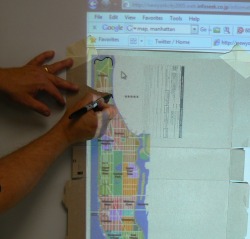
Another really cool use for an empty cereal box:
Tape it to the wall, use your projector to shine a map onto it, trace and cut out the map and you've got a really good stencil of Manhattan for the back of the shirt.
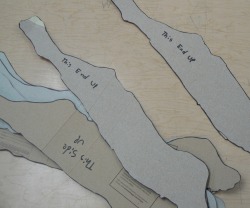
For four classes of up to twenty students, I cut out about a dozen stencils. This turned out to be just about right. I made sure to mark the stencils to indicate which side goes up. It would be a pity to have them show off all their knowledge of Manhattan with the map backwards.
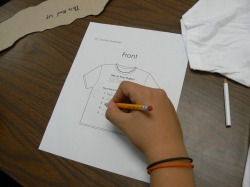
Another bonus is that it let me pre-emptively check their spelling.
| nyc_tee_shirt_worksheet.doc |
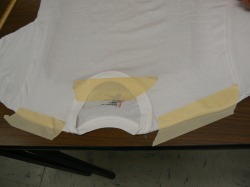
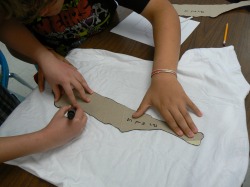
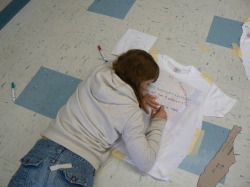
Some of the students felt more comfortable working on the floor.
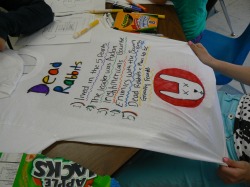
Once students had gotten their basic information down, they were allowed to decorate their shirts however they wanted.
[This girl had researched the 19th Century Irish streetgang, the Dead Rabits.]

The end results were pretty satisfying. The students were engaged. They demonstrated authentic learning and they had fun.
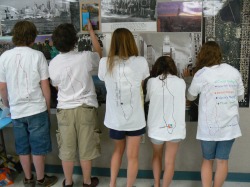
Mind you - at this point, we haven't actually gone through the question-answering process. I'll update you on how that goes next week.
Well, we've been through the question-answering process and it seems promising. The students were very motivated for most of the day and were really eager to pigeonhole adults and share information about their projects. Things got a little bit rocky at the end of the day, but with a few tweaks, the process should go much smoother next year.
Glitch #1 - Not Enough Adults To Go Around
Tucked away in our own corner of the school, the 8th graders did not get a chance to really show off their knowledge to new adults unfamiliar with their work. Next year, we should have some sort of reception and invite adults to come look at their projects and do the t-shirt questioning process then, as well as throughout the day.
Glitch #2 - A Few Students Gaming the System
A few of our students got together and pooled their tickets in an explicit attempt to "keep the smart kids from winning". This took a bit of the air out of the second half of the day. We should have anticipated this, but somehow, it slipped under our radar. (To be fair, I had never said that they couldn't do this.) A few of the students gave up at that point, realizing that they couldn't accumalate enough tickets to compete with The Pool.
Next year, even though it will mean more work for the adults, when an adult awards a ticket, we'll have them write the kid's name on the back of it in ink and initial it. Also, we'll award the grand prize based on the number of tickets, but then put all the other tickets into a hat and draw two other winners to keep students motivated.
Glitch #3 - Spoiler
Somehow, one of our students found out what the grand prize was and made sure that all the other students knew within a matter of minutes. This made the end of the day extremely anticlimactic and many of the students came out of the project feeling very dejected. I guess the only way to prevent that next year is to use air-tight security.
Overall Assessment of the T-Shirt Project:
Almost every new project or activity has rough spots the first time through. I think that this t-shirt activity has a lot of promise. We'll try it again next year and see how it goes.
Project Idea Grade - A Minus
Project Execution Grade - B Minus
 RSS Feed
RSS Feed